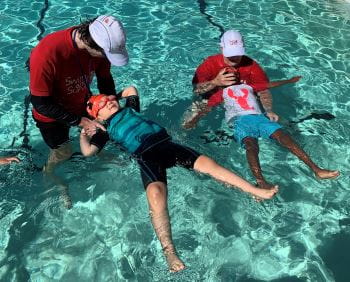Dianella children learn to Swim and Survive
Australia is a diverse nation, with almost half of Australians either born overseas themselves or with a parent who was, while more than 7.5 million people have migrated to Australia since 1945. Sadly many of those coming to Australia from overseas often lack the vital swimming and water safety skills required to fully enjoy our water-loving lifestyle, and this can have tragic consequences. Statistics from a national report on drowning show that 347 people drowned in WA between 2005/06 and 2015/16, of which almost 40% were born overseas - the highest proportion of any state of territory.
As we work to turn these statistics around, Royal Life Saving WA, with support from Principal Community Partner BHP, is running a nine-week Swim and Survive program for multicultural children. The program began in February and runs through to April, with the Metropolitan Migrant Resource Centre, Dianella Secondary College and local primary and high schools identifying local children who are at risk of not learning swimming and water safety skills.
 120 multicultural children aged 4-17 years are participating in the program, which aims to break down the barriers to participation, whilst keeping it cost effective and ensuring participants feel connected to their community. The program is particularly important for schools like Dianella Secondary College, which is located in the City of Stirling. Dianella has a very high multicultural student demographic, with 2011 Australian Bureau of Statistics data showing that 38.5% of the population in the area were born overseas. The City of Stirling is ranked in the top 10 most Culturally and Linguistically Diverse Local Government area in Western Australia.
120 multicultural children aged 4-17 years are participating in the program, which aims to break down the barriers to participation, whilst keeping it cost effective and ensuring participants feel connected to their community. The program is particularly important for schools like Dianella Secondary College, which is located in the City of Stirling. Dianella has a very high multicultural student demographic, with 2011 Australian Bureau of Statistics data showing that 38.5% of the population in the area were born overseas. The City of Stirling is ranked in the top 10 most Culturally and Linguistically Diverse Local Government area in Western Australia.
A key objective of Royal Life Saving is to introduce the Swim and Survive swimming and water safety program to all cultural groups across WA. Research has found that within these groups, there are alarmingly low participation levels in swimming and water safety programs, while their awareness of the importance of swimming and water safety and lifesaving skills is significantly lower than the rest of the population. This contributes to their over-representation in drowning statistics.
Royal Life Saving Society WA Senior Manager Swimming and Water Safety Education Trent Hotchkin says, “We continue to work hard right across Western Australia, partnering with relevant community groups to ensure those from all cultural and social backgrounds acquire vital swimming and water safety skills. We are committed to teaching every child to Swim & Survive, and we recognise that this task is all the more important given WA’s climate and lifestyle that encourages so much activity in and on the water. We’re determined to ensure each new generation acquires these skills, and no-one misses out, no matter who they are or where they live.”
The Royal Life Saving Swim and Survive Access & Equity Program, supported by our Principal Community Partner BHP, aims to reduce barriers to participation, by providing culturally appropriate, quality swimming and water safety lessons for children experiencing social or economic disadvantage. The Program achieves this by increasing access to safe aquatic facilities, qualified instructors and by providing structured swimming and water safety education via the Swim & Survive program.
Meath Hammond, BHP Head of Corporate Affairs says “Water recreation is a big part of the Western Australian lifestyle and water safety is an important safety issue in regional and remote areas. We hope our renewed partnership will improve the accessibility of water safety programs and include more members of the community in swimming education, so that our communities become safer places to live and work."
Find out more about the Swim and Survive Access and Equity program and how it might assist your community at the link below.
